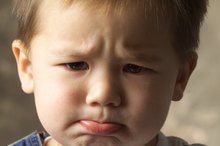Definition of Proactive Aggression
In the classic example of schoolyard bullying, a larger child strides over to a smaller child, pushes her to the ground and demands her lunch money. In another scenario, a tormented child strikes back at a bully, seemingly without thought, driven by terror and rage. The differences between these scenarios lie in the presence of proactive versus reactive aggression, two different forms of aggression recognized by psychologists as stemming from different motives, levels of emotional arousal and physiological processes.
What Is Aggression?
As psychologist and aggression expert Leonard Berkowitz points out, aggression is difficult to define, and even clinicians and researchers who work with it every day cannot agree on a definition. Everyday usage of the term only clouds the issue further. Aggression, he concludes, "is any form of behavior that is intended to harm someone physically or psychologically." Key to Berkowitz's definition is the motive to cause harm, excluding accidental, wrongful (but not harmful) and assertive behavior. The child who intentionally shoves a classmate against a locker is aggressive. The clumsy child who accidentally trips a peer, the child who steals from an absent classmate's desk and the child who interrupts and argues in a class discussion are not aggressive.
Proactive vs Reactive Aggression
Social Learning Theory in Children
Learn More
Proactive aggression, also called instrumental aggression, is carried out with a purpose in mind that extends beyond simply harming the victim. Reactive or emotional aggression, on the other hand, is primarily intended to cause harm. Proactive aggression tends to be calculated--the person knows before the aggressive act occurs that he intends to harm the other person--while reactive aggression is impulsive and often caused by strong emotion, such as fear or anger.
Motives
An afternoon watching young children on the playground--or a look back through history--reveal the myriad motives for proactive aggression. Researchers Gerald Patterson and James Tedeschi propose that proactive aggression is motivated by a desire to change the victim's behavior. For example, a bullied child plots to harm and humiliate his tormentors in hopes that the bullying will stop. Berkowitz cites another school of thought that carries this idea further, proposing that proactive aggression can establish the aggressor's dominance over the victim, a model that is commonly used to explain domestic violence. Sociologist Richard Felson attributes proactive aggression to the desire to manage how others perceive the aggressor. For example, gang members often want to be regarded as formidable and intimidating, and they manufacture this impression by acting violently toward others. Other motives also exist, such as the desire for money or social approval.
Perceived Hostility and Planning Ability
Signs of a Sociopath in Children
Learn More
A 2009 study by Ellis, Weiss and Lochman found that children who showed proactive aggression distinguished themselves from reactive aggression and normal children in two major ways. Firstly, they did not perceive their victims as having harmful intentions. Children with reactive aggression often lash out because they believe that another person intends to harm them. Secondly, proactive aggressors had better planning abilities, allowing them to calculate and plan their aggressive actions in advance.
Reactions to Stress
Reactive aggression is impulsive and driven by heightened emotion, leading to familiar turns of phrase such as "in the heat of the moment" and "crimes of passion." Lashing out in fear and anger, emotionally aggressive people often seem unable to control their behavior. Perhaps not surprisingly, then, studies of aggressive children show underlying physiological differences between those that demonstrate proactive versus reactive aggression. Child psychologist Nestor Lopez-Duran and colleagues found that reactively aggressive children showed physiological stress responses during stressful tasks while proactively aggressive children did not, lending credence to the familiar description of instrumental violence occurring "in cold blood."
Related Articles
References
- "Aggression: Its Causes, Consequences, and Control;" Leonard Berkowitz; 1993
- "Social Interaction: Methods, Analysis, and Illustration;" A Performance Theory for Coercive Family Interactions; Gerald R. Patterson; 1979
- "Aggression: Theoretical and Empirical Reviews," Volume One; Social Influence Theory and Aggression; James T. Tedeschi; 1983
- "Social Psychology;" Aggression as Impression Management; Richard B. Felson; 1978
- "Journal of Abnormal Child Psychology;" Executive Functions in Children: Associations with Aggressive Behavior and Appraisal Processing; M. Ellis, B. Weiss, and J. Lochman; 2009









